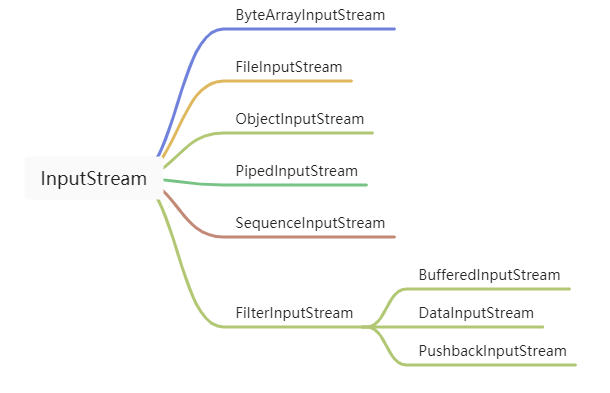Guava IO
日常系统交互中,文件的上传下载都是常见的,一般我们会通过jdk提供的IO操作库帮助我们实现。IO指的是数据相对当前操作程序的入与出,将数据通过 输出流从程序输出,或者通过输入流将数据(从文件、网络、数据等)写入到程序,这里的IO指的是基于流作为载体进行数据传输。如果把数据比作合理的水,河就是IO流,也是数据的载体。
Java为我们提供了非常多的操作IO的接口与类,帮助开发者实现不同源间的数据传输,比如硬盘文件、网络传输、应用调用间的数据交互与传递。今天我们来简单了解下Java中的流 以及在Guava工具包中,针对IO操作做了什么样的封装与设计。
分类
在java.io包中有非常多的IO相关接口,我们可以根据流的输出类型、处理对象以及功能将其分为以下几种类型:
- 按数据流向
- 输入流 (java.io.InputStream)
用于实现将数据读入到程序 - 输出流 (java.io.OutputStream)
用于实现将数据从程序写出
- 输入流 (java.io.InputStream)
- 按操作单位
区分:
字节流一般以Stream结尾 字符流一般以Reader或Writer结尾
- 按操作方式
- 读 (java.io.Reader)
主要针对字符流的读取操作 - 写 (java.io.Writer)
主要针对字符流的写出操作
- 读 (java.io.Reader)
- 按功能
- 缓存流
按字节进行数据读写时,通过缓冲批量写入来提高传输效率 - 转换流
实现输入/出与读/写方式间的转换
- 缓存流
常用的流
- 操作文件的
java.io.FileinputStream/FileOutputStream java.io.FileReader/FileWriter - 通用的字节流
java.io.InputStreamReader/outputStreamWriter - 缓冲流
java.io.BufferedReader/BufferedWriter java.io.BufferedInputStream/BufferedOutputStream - 数据流
java.io.DataInpoutStream/DataOutputStream - 功能型的
java.io.PrintWriter/PrintStream - 对象序列化相关的
java.io.ObjectInputStream/ObjectOutputStream
可见,提供的IO对象基本都是成对出现的,用以完成数据的输入输出,实现程序与外部载体间的数据交换
示例
下面我们通过一些常用示例来看看IO的使用的场景与使用方法:
- 文件复制
- 文件的合并
- 读取文件内容为字符串
- 字节数组转换成流
- 对象序列化与反序列化
- 流的转换
- ......
- 文件复制
@Test
public void copyByBytes() throws IOException {
String root = FileTests.class.getResource("/").getPath();
FileInputStream fis = new FileInputStream(new File(root,"/start.bat"));
FileOutputStream fos = new FileOutputStream(root+"/out2.bat");
byte[] buff = new byte[100];
int b;
while ( (b = fis.read(buff))!=-1 ){
fos.write(buff, 0, b);
}
// close
}
- 文件合并
@Test
public void mergeFiles() throws IOException {
File file1 = new File("E:_projectssuclsblogmy_studyguavaguava-iosrctestjavacomsuclsblogguavaiocategoryFileTests.java");
File file2 = new File("E:_projectssuclsblogmy_studyguavaguava-iosrctestjavacomsuclsblogguavaiocategoryStreamTests.java");
Enumeration< InputStream > ins = Collections.enumeration(Arrays.asList(
new FileInputStream(file1),
new FileInputStream(file2)
));
SequenceInputStream sequenceInputStream = new SequenceInputStream(ins);
FileOutputStream fos = new FileOutputStream(root+"/out4");
byte[] buff = new byte[100];
int read; // 真实读取到的字节数
while ( (read = sequenceInputStream.read(buff)) !=-1){
fos.write(buff, 0, read);
}
fos.close();
}
- 读取文件内容为字符串
@Test
public void readStringFromFile() throws IOException {
FileReader fileReader = new FileReader(new File(this.getClass().getResource("/").getPath(),"/start.bat"));
StringBuilder stringBuilder = new StringBuilder();
int i;
while ( (i = fileReader.read())!=-1 ){
stringBuilder.append( (char)i ); // 按字符读取
}
System.out.println( stringBuilder ); // 文件内容
}
- 字节数组转换成流
@Test
public void bytesToStream(){
byte [] data = new byte[1024]; // 来源于其他数据源
ByteArrayInputStream inputStream = new ByteArrayInputStream(data);
ByteArrayOutputStream outputStream = new ByteArrayOutputStream();
int v;
while ( (v=inputStream.read())!=-1 ){
outputStream.write(v);
}
System.out.println( Arrays.toString( outputStream.toByteArray() ));
}
- 对象序列化与反序列化
@Test
public void objectToFile() throws IOException {
Person person = new Person();
person.setName("张三").setAge(25);
String root = FileTests.class.getResource("/").getPath();
FileOutputStream fos = new FileOutputStream(new File(root,"/person"));
ObjectOutputStream oos = new ObjectOutputStream(fos);
oos.writeObject(person);
}
@Test
public void fileToObject() throws IOException, ClassNotFoundException {
String root = FileTests.class.getResource("/").getPath();
FileInputStream fis = new FileInputStream(new File(root,"/person"));
ObjectInputStream ois = new ObjectInputStream(fis);
Person person = (Person) ois.readObject();
System.out.println( person );
}
- 流的转换 将字节流转换成字符流来操作,同样以文件复制为例
@Test
public void copyByBuffer() throws IOException {
String root = FileTests.class.getResource("/").getPath();
FileInputStream fis = new FileInputStream(new File(root,"/start.bat"));
InputStreamReader isr = new InputStreamReader(fis);
BufferedReader br = new BufferedReader(isr);
FileOutputStream fos = new FileOutputStream(root+"/out3.bat");
OutputStreamWriter osw = new OutputStreamWriter(fos);
BufferedWriter bw = new BufferedWriter(osw);
String line;
while ( (line = br.readLine())!=null ){
bw.append(line);
bw.newLine();
bw.flush();
}
// close
}
关于流的操作非常多,像包括网络通信中、音视频文件处理、流合并等等
Guava中的IO
关于IO的内容并不复杂,上面的那些例子在很多工具库中基本都会提供对应的API方便开发者调用,今天主要看下Guava IO模块针对流的操作提供了什么样的 封装
Files
提供对文件快捷读写方法 其中主要提供了ByteSource、ByteSink、CharSource、CharSink 4个类,分别对应按字节的读写与按字符的读写,
/**
* 文件复制
*/
@Test
public void copy() throws IOException {
File from = new File(root,"from");
File to = new File(root,"to");
Files.copy(from,to);
}
/**
* 文件移动
*/
@Test
public void move() throws IOException {
File from = new File(root,"from");
File to = new File(root,"to");
Files.move(from,to);
}
/**
* 按行读取文件
* @throws IOException
*/
@Test
public void readLines() throws IOException {
File dest = new File(root,"start.bat");
List< String > lines = Files.readLines(dest, Charset.defaultCharset());
lines.forEach(System.out::println);
}
/**
* 写入文件
* @throws IOException
*/
@Test
public void writeToFile() throws IOException {
File dest = new File(root,"demo.txt");
Files.write("hello world!".getBytes(Charset.defaultCharset()), dest);
}
/**
* 修改文件更新时间
* @throws IOException
*/
@Test
public void touch() throws IOException {
File dest = new File(root,"demo.txt");
Files.touch(dest);
}
/**
* 文件的零拷贝
* @throws IOException
*/
@Test
public void map() throws IOException, URISyntaxException {
File from = new File(root,"from");
File to = new File(root,"to");
Files.touch(to);
MappedByteBuffer fromBuff = Files.map(from, MapMode.READ_ONLY, 1024);
// = >
FileChannel channel = FileChannel.open(Paths.get(to.toURI()), StandardOpenOption.WRITE);
channel.write(fromBuff);
channel.close();
}
/**
* 读文件为字节数组
* @throws IOException
*/
@Test
public void fileAndBytes() throws IOException {
File dest = new File(root,"start.bat");
ByteSource byteSource = Files.asByteSource(dest);
byte[] bytes = byteSource.read();
System.out.println( bytes );
// 字节写入文件,实现复制
File target = new File(root, "start2.bat");
ByteSink byteSink = Files.asByteSink(target);
byteSink.write(bytes);
}
@Test
public void wrapper(){
File dest = new File(root,"start.bat");
// 作为字节读
Files.asByteSource(dest);
// 作为字节写
Files.asByteSink(dest);
// 作为字符读
Files.asCharSource(dest, Charset.defaultCharset());
// 作为字符写
Files.asCharSink(dest, Charset.defaultCharset());
}
其他
管道流
PipedOutputStream PipedInputStream 实现多线程间的数据通信;类似生产消费者模式
@Test
public void pipe() throws IOException {
PipedOutputStream pipedOutputStream = new PipedOutputStream();
PipedInputStream pipedInputStream = new PipedInputStream();
pipedOutputStream.connect(pipedInputStream);
new Thread(()- >{
while (true){
String date = new Date().toString();
try {
pipedOutputStream.write( date.getBytes(StandardCharsets.UTF_8) );
pipedOutputStream.flush();
TimeUnit.SECONDS.sleep(2);
} catch (IOException e) {
throw new RuntimeException(e);
} catch (InterruptedException e) {
throw new RuntimeException(e);
}
}
}).start();
new Thread(()- >{
while (true){
byte [] buff = new byte[1024];
try {
int read = pipedInputStream.read(buff);
TimeUnit.SECONDS.sleep(4);
} catch (IOException e) {
throw new RuntimeException(e);
} catch (InterruptedException e) {
throw new RuntimeException(e);
}
System.out.println( new String(buff) );
}
}).start();
}
结束语
在任何编程语言中,数据的IO都是比较常见并相当重要的。Guava作为工具型类库,主要是帮助开发者封装常用、重复的操作,开放出简介的API,不仅能让让代码更加整洁, 同时对开发出稳健程序也是比不可少的。
-
IO
+关注
关注
0文章
448浏览量
39128 -
数据传输
+关注
关注
9文章
1872浏览量
64536 -
硬盘
+关注
关注
3文章
1308浏览量
57280 -
JAVA
+关注
关注
19文章
2964浏览量
104686 -
工具包
+关注
关注
0文章
46浏览量
9528
发布评论请先 登录
相关推荐
Java中的输入输出流盘点
Java 那些最常用的工具类库
java流与文件实验
java中的io流分析

关于java中的io流知识总结详解
理解Java中字符流与字节流的区别





 java中的IO流与Guava工具
java中的IO流与Guava工具












评论